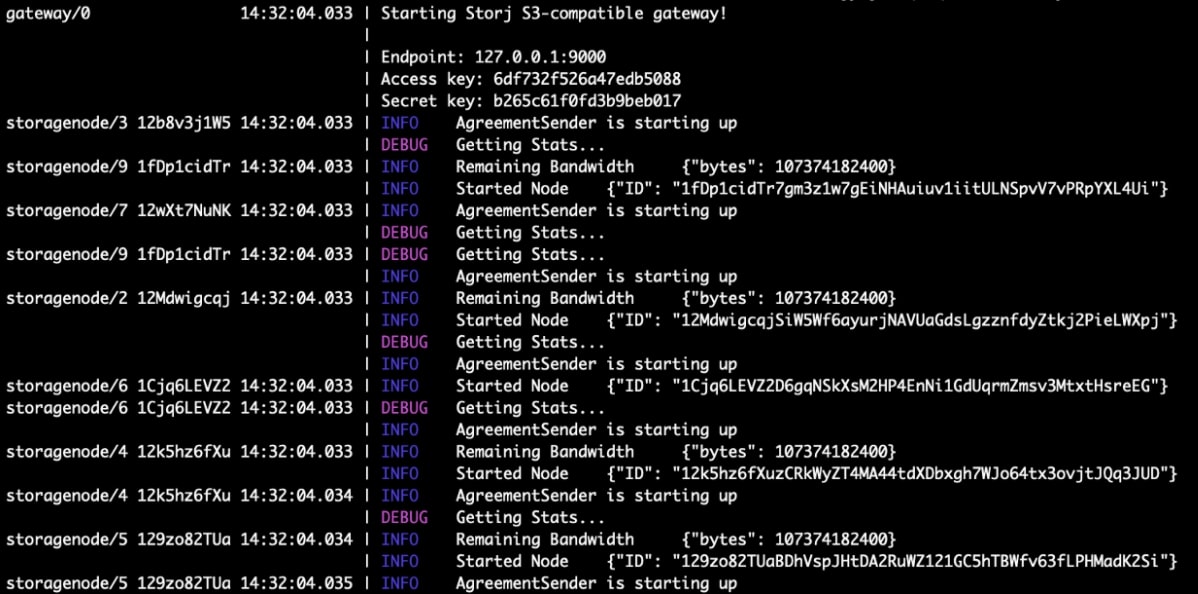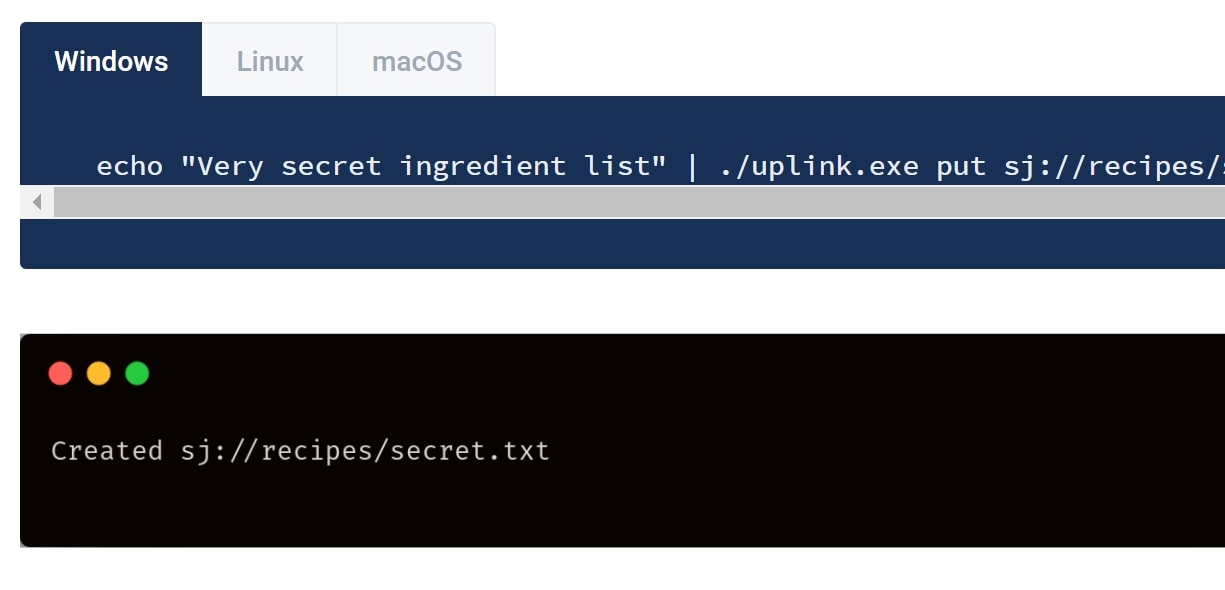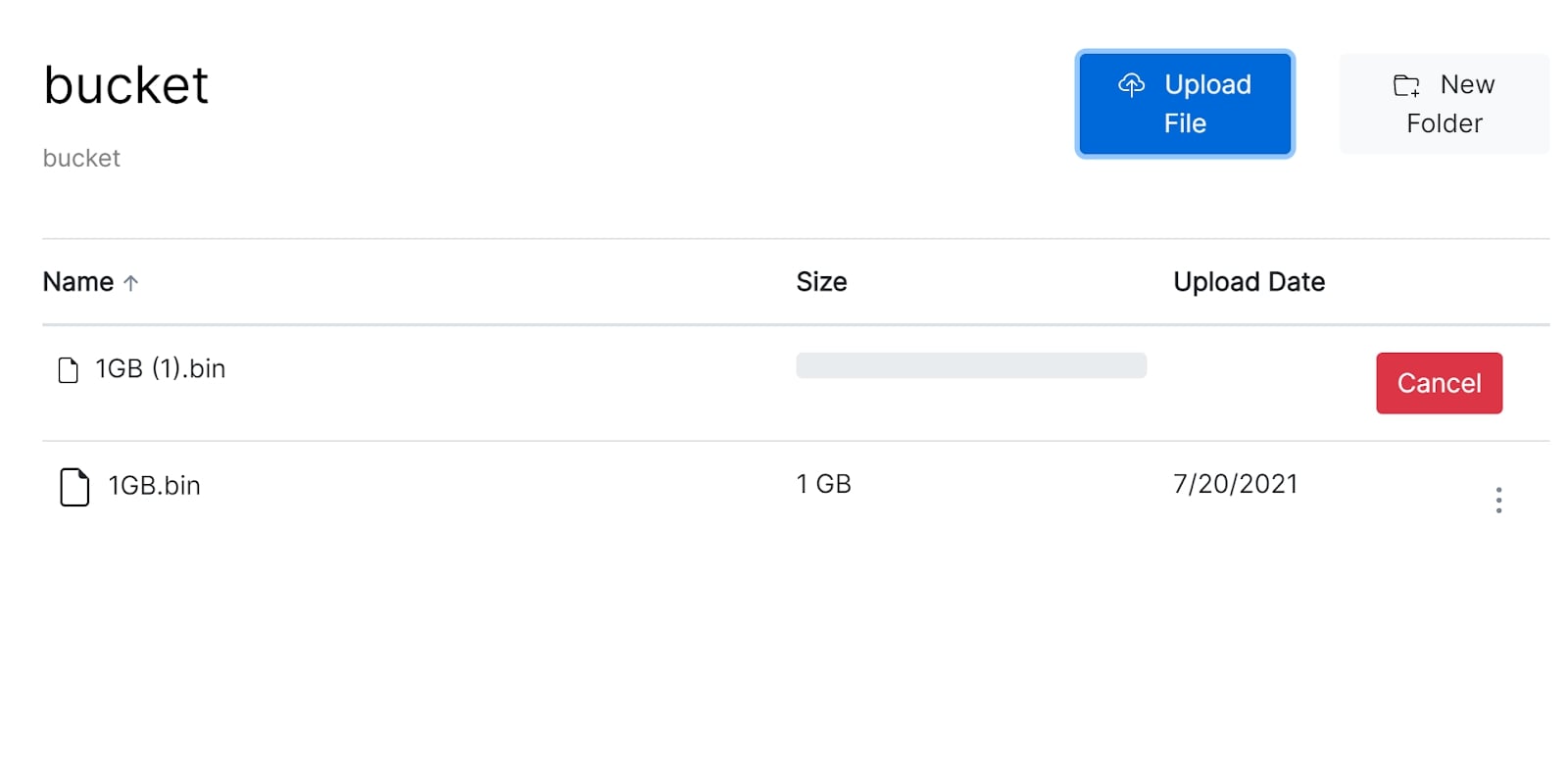Storj review
Our Storj review will help you decide whether this decentralised cloud storage platform is right for you

Storj is a decentralised cloud storage system that offers security, speed, and redundancy. Many features require you to use a command line interface, so this platform is best suited for those comfortable with programming.
-
+
Decentralized cloud storage with over 10,000 servers
-
+
End-to-end encryption with command line
-
+
150GB of free storage
-
-
Command line interface can be complex
-
-
Limited file sharing tools using web client

Storj is a decentralised cloud storage platform. The service cuts your files into 80 pieces, and then distributes those pieces across a global server network. In our Storj review, we’ll cover everything you need to know to decide if this is the best cloud storage service for you.
Storj review: Snapshot
Storj gives new users up to 150GB of free storage, which is extremely generous. Pricing for paid users is variable based on the amount of storage space and bandwidth you use, but is cheap compared to most traditional cloud storage providers.
As a result of the system being decentralised, you get top-tier security, extreme redundancy against server failures, and ultra-fast download speeds from anywhere in the world. In addition, Storj is fully open-source, which is a plus for security-conscious users.
While Storj does offer a web client for simplified uploading and downloading, the real power of this service lies in its command line interface. Overall, Storj is best suited for programmers who want to make use of the command line controls and won’t be overwhelmed by the service’s complexity.
Score: 4/5
Read on for the full Storj review.
Storj's competitors
How does Storj compare to its main competitors?
| Header Cell - Column 0 | Storj | pCloud | Microsoft |
|---|---|---|---|
| Score | 4/5 | 4/5 | 4.5/5 |
| Pros | Fully decentralised cloud storage - End-to-end and server-side encryption - 150GB of free storage | Simple, robust file versioning - File syncing across devices - Low-cost individual and family plans | Unlimited end-to-end encryption with premium plans - Includes Office apps for collaboration - Highly secure file sharing |
| Cons | Many tasks require command line interface - Variable costs based on storage and bandwidth | No real-time collaboration tools - End-to-end encryption costs extra | Expensive pricing options - Limited free storage |
| Verdict | Storj is a unique cloud storage solution that prioritises security, reliability, and speed. It’s ideal for programmers who want a command line interface, but may be overly complex for average users. | pCloud is a robust cloud storage platform that offers excellent security, file versioning, and sharing tools at a reasonable price. It’s also very easy to use. | Microsoft OneDrive is one of the best cloud storage platforms for collaboration, especially if you rely on Office 365 apps. However, it doesn’t offer the most storage space for your buck. |
| View deals | <a href="https://www.storj.io&aff_click_id=hawk-custom-tracking">Visit site</a> | <a href="https://www.pcloud.com">Visit site</a> | <a href="https://onedrive.live.com/&aff_click_id=hawk-custom-tracking">Visit site</a> |
Storj: Key features
The first thing to know about Storj is that it uses a fundamentally different method to store your data than most comparable cloud storage services. Instead of taking your files and uploading copies of them to a handful of US-based servers, Storj uses a decentralised storage algorithm.
When you upload a file, Storj splits it into 80 overlapping pieces, and then places each piece on a different server. The company has over 10,000 servers, or “nodes,” spread across 84 different countries. When you want to download or move your files, Storj only needs to access 29 pieces of each file to put the whole thing back together.

There are several advantages to using this decentralised storage scheme. First, your backups are extremely redundant. Storj keeps 80 pieces of each file, but only needs 29 pieces to recover the file. Better yet, those 80 pieces are stored across servers in dozens of different countries. In effect, it’s virtually impossible to lose files that you upload using Storj.

Another advantage to decentralised storage is that you can access files extremely quickly from anywhere in the world. The platform will automatically download pieces of your files from the servers closest to your location, which helps speed up downloads. This is particularly helpful if you need to share large files across a globally distributed team.
Finally, Storj’s decentralised storage system makes your data more secure. Even if a malicious attacker were able to break into one of Storj’s servers, they wouldn’t be able to reconstruct your files without breaking into an additional 28 servers. Even then, all file pieces are encrypted at rest on Storj’s servers, so they’re essentially uncrackable without your encryption key.

Storj also offers end-to-end encryption when you upload files using either Rclone or Storj’s own command line interface. These options both enable you to connect directly to Storj’s server network through a secure gateway. However, Rclone and the command line interface are notably more complicated for non-programmers than Storj’s web client, since you need to write code to initiate uploads and downloads.
Storj: What’s new in 2022?
Storj’s development team is relatively active, and releases updates every few months. Most recently, the team released a Linux installer and created software that can track server downtime. The latter is particularly useful since Storj’s algorithm chooses which servers to send file pieces to based on uptime. This change ensures that your files are being stored on the most reliable servers.
Storj has also added a number of command line functions that enable users to migrate data from traditional cloud storage services to Storj. That’s big news for anyone who already has a lot of data in the cloud, as it makes it much simpler to automate the process of switching to Storj.
We’ve also been happy to see Storj fix some small but irksome issues. For example, it’s now possible to rename individual files. Until recently, it was necessary to reupload a file in order to change its name.
Storj: Pricing
Storj offers up to 150GB of free storage, which is roughly 10 times more than most traditional cloud storage providers. This free storage is subdivided into three projects, with a maximum capacity of 50GB each. In addition, there’s a 150GB limit on your monthly bandwidth usage.
If you need more storage capacity or bandwidth, Storj charges according to the amount you use. Storage costs £3.26 per TB a month, while bandwidth costs £5.71 per TB a month. You can easily keep track of your estimated monthly bill through the web dashboard.
Storj's pricing plans
| Plan type/feature | Free | Standard |
|---|---|---|
| Storage | 50GB per project | £3.26 per TB a month |
| Bandwidth | 50GB per project | £5.71 per TB a year |
| Projects | One | Three |
Testing Storj
To better benchmark Storj against its competitors, we analysed how to use its web client, and investigated its command-line interface, as well as its upload speeds (a key factor in terms of cloud storage) and its file sharing capabilities.
How do you use Storj's web client?

The Storj web client is the simplest way to access Storj, although it does limit the platform’s functionality. With the web client, you can create buckets to store your files, grant access to individual users, and set up encryption keys for server-side encryption.
However, any files you upload using the web client won’t be encrypted before they leave your computer, and you have no control over which servers your file pieces are sent to.
One reason that even programmers might want to use the web client is the dashboard. That’s because it clearly shows how much total storage and bandwidth you’ve used for the month, and it even provides an estimate for how much you’ll be charged at the end of the month.
What's Storj's command-line interface like?

Storj offers an executable that can be accessed from the command line in Windows, Mac, and Linux. The command line offers much more flexibility compared to the web client, although it does require users to be comfortable with basic programming. At a minimum, you’ll need to be able to navigate your computer’s file system through the command line in order to use Storj.
We found that simply uploading and downloading files using the command line is relatively straightforward. Storj offers a very detailed guide to the available commands, complete with examples. In addition, most non-standard processes are controlled by flags, so there are less than a dozen commands in total to remember.
How fast is Storj?

We tested Storj’s speed by uploading and downloading a 1GB file over a 110Mbps internet connection. The upload process took just over 25 minutes, which was relatively fast considering that this process also required breaking the file into 80 pieces, and determining which servers to upload those pieces to.
Downloading that same file was incredibly speedy—it took just one minute and 13 seconds. In fact, Storj’s download speed was among the fastest we’ve ever experienced with a cloud storage service.
What file sharing options does Storj offer?

We also tested out file sharing with Storj, since the ability to work across global teams is one of the main advantages of decentralised cloud storage. Unfortunately, you don’t have many options around sharing if you’re using the web client. You can create a share link, but you can’t set editing permissions, add password protection, or set an expiration date.
However, if you turn to the command line interface, Storj offers a lot more control. You can enter any path to share, which enables you to share individual files or entire folders. In addition, the share command includes flags to control editing permissions or to create a shareable URL to your data. You can also add an expiration time, or even restrict access to a file up until a certain time.
Alternatives to Storj
Storj is somewhat unique among cloud storage providers because of its decentralised storage model. However, it’s worth comparing this platform to pCloud and Microsoft OneDrive, both of which offer strong security and large storage volumes.
Storj narrowly beats out both pCloud and OneDrive when it comes to pricing. You can get 1TB of storage at Storj for as little as £39 a year, but pCloud’s 2TB plan is comparable at £99.99 a year. Microsoft only sells 1TB plans for £79.99 a year. While that might look pricey at first, it’s important to note that Microsoft throws in its full suite of Office 365 apps. In addition, keep in mind that Storj charges for bandwidth, whereas pCloud and Microsoft do not.
The main thing you should consider when choosing between these three platforms is what type of experience you want. Storj is designed for advanced users who are comfortable with programming, and who prefer object-oriented storage over a traditional file system.
pCloud is more suitable if you want to sync files across multiple devices, and want simple sharing and file versioning tools. Microsoft OneDrive has many of the same features that pCloud offers, but the addition of the Office 365 suite makes it best for real-time collaboration.
Storj's features compared to the competition
| Header Cell - Column 0 | Storj | pCloud | Microsoft |
|---|---|---|---|
| End-to-end encryption | ✔ | ✔ | ✔ (email only) |
| File sharing | ✔ (with upgrade) | ✔ | ✔ (email only) |
| Support | ✔ | ✔ | ✔ (phone, email, and live chat) |
| Basic plan | £3.26 per TB a month | £4.16 a month for 500GB | £1.99 a month for 100GB |
Storj: The verdict
Storj is a unique cloud storage service that uses decentralisation to offer speed, security, and reliability. With this platform, files are quickly accessible from anywhere in the world, and there’s virtually no chance that data could be hacked or lost. Our testing found that Storj has among the fastest download speeds of any cloud storage provider.
On top of that, Storj is incredibly inexpensive. The platform offers 150GB for free, and charges just £3.26 per terabyte a month after that. That’s a fraction of what most traditional cloud storage providers charge.
The catch to Storj is that it’s more complicated to use and less feature-rich than competitors like pCloud or Microsoft Office. While it’s possible to get by with the Storj web client, most of the platform’s flexibility is derived from its command line interface. We thought the command line interface was relatively straightforward, but it still requires familiarity with programming.
Overall, Storj is a strong option for users with a large amount of data and who are comfortable using the command line. It’s especially useful for globally distributed teams, and for storing sensitive data in the cloud.
Further reading on cloud storage
Learn more about cloud storage in our comparison pitting cloud storage vs local storage; our discussion on how you can start reducing cloud storage costs; and our buying guides evaluating the best free cloud storage, and the best cloud storage for photos.
Get the ITPro daily newsletter
Sign up today and you will receive a free copy of our Future Focus 2025 report - the leading guidance on AI, cybersecurity and other IT challenges as per 700+ senior executives
Michael is a prolific author in business and B2B tech, whose articles can be found on Business Insider, Entrepreneur, TechRadar Pro, IT Pro Portal, Tom's Guide, and more, covering everything from international tech regulations to corporate finance and emerging tech brands and markets. A successful copywriter and entrepreneur, Michael has worked with dozens of SaaS and tech companies, and has his finger firmly on the pulse of B2B tech, finance and business.
-
 ‘Phishing kits are a force multiplier': Cheap cyber crime kits can be bought on the dark web for less than $25 – and experts warn it’s lowering the barrier of entry for amateur hackers
‘Phishing kits are a force multiplier': Cheap cyber crime kits can be bought on the dark web for less than $25 – and experts warn it’s lowering the barrier of entry for amateur hackersNews Research from NordVPN shows phishing kits are now widely available on the dark web and via messaging apps like Telegram, and are often selling for less than $25.
By Emma Woollacott Published
-
 Redis unveils new tools for developers working on AI applications
Redis unveils new tools for developers working on AI applicationsNews Redis has announced new tools aimed at making it easier for AI developers to build applications and optimize large language model (LLM) outputs.
By Ross Kelly Published
-
 Google layoffs continue with "hundreds" cut from Chrome, Android, and Pixel teams
Google layoffs continue with "hundreds" cut from Chrome, Android, and Pixel teamsNews The tech giant's efficiency drive enters a third year with devices teams the latest target
By Bobby Hellard Published